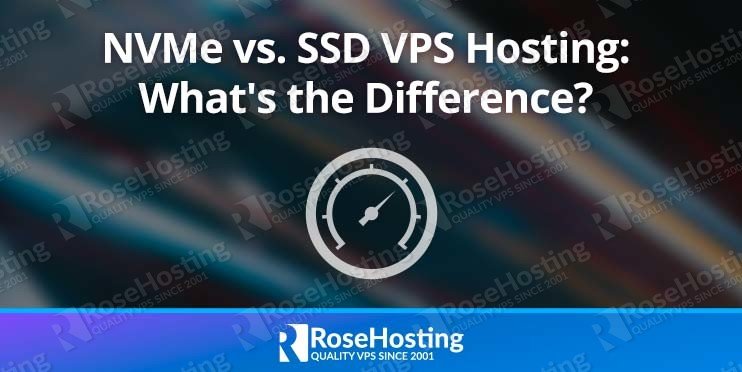
When seeking an ideal solution for your web-based projects or applications, you will come across many VPS hosting options. And whether you’re an eCommerce store owner, a website designer, or an expert blogger, the performance of your project crucially depends on the storage technology that your hosting server uses.

The type of storage that is used by your VPS has the largest effect on your user’s perceived speed and responsiveness. This is the reason why storage technologies are evolving rapidly to support robust, powerful, and faster web hosting. In this post, we’ll look at the difference between NVMe vs. SSD VPS Hosting. Both are solid-state, however, the differences between them can give you significantly different results. Let’s get into it.
Table of Contents
What is NVMe technology?
NVMe stands for Non-Volatile Memory express. It is a new and innovative communication interface that addresses limitations posed by previous storage technologies. The NVMe protocol is designed for seamless use of high-speed storage media. It too is solid-state like SATA (Serial ATA) SSDs, however the speed and performance is anything but similar.
To break it down, NVM (Non-volatile memory) is a memory that can retain its stored data even if the system’s power gets cut. On the other hand, volatile memory loses stored data when there is no power. SSDs, spinning disks, and other disk storage drives are all examples of non-volatile memory. Keeping that in mind, NVMe technology uses non-volatile memory to retain your data, even if the power is lost.
NVMe also uses a newer interface to communicate with the CPU and operating system – PCI express, or PCIe. This is a much faster interface than SATA or SAS. This new interface can communicate directly with the CPU, allowing for much higher bandwidth (and therefore greater speeds), as well as lower response times.
What is SSD?
SSD (Solid State Drives) is hardware that uses solid-state storage technology to store data using flash memory. There are several types of flash storage, however NAND storage is the most common.
We know SSDs deliver significantly faster read/write speeds than traditional HDDs (Hard Disk Drives). However, SSDs also have some limitations when it comes to maximum speed for storage protocols.
SSDs generally operate under the SATA and SAS interfaces, which hinder the performance of faster drives. Originally, the SATA interface was designed for HDDs and was also widely used for early SSDs to better support backwards compatibility. But as time passed, SATA posed limitations to the SSDs abilities.
To address this problem, developers designed the NVMe protocol which relies on the PCI Express (PCIe) interface. This interface allows NVMe to offer faster speeds, better performance and enhanced reliability altogether. All of these fall under the same name of an “SSD”, since they all use solid-state memory to store data.
Initially, NVMe drives were offered as add-in cards with PCI 2.0 or PCIe 3.0 interfaces. These were to be connected to the PCIe socket of the server’s motherboard. Later on, 2.5” NVMe drives were designed that connected to the motherboard via a U.2 or U.3 connector.
NVMe vs SSD: What’s the difference?
Just like NVMe, SSD is also a type of non-volatile memory and it reads/writes data only via electronic circuits.
So, if both SSD and NVMe drives are solid-state storage devices, what’s the difference between them?
As mentioned above, the difference lies in the ‘e’ in NVMe, which stands for Express. Express is a new protocol, specifically designed to enhance the internal parallelism and low latency of SSDs. This means that NVMe storage connects the storage drive to the server’s motherboard using a faster, newer interface, utilizing the direct PCIe lanes of the CPU.
That’s the main difference between NVMe and SSDs – both use the solid-state storage technology to store data, but NVMe features a newer, faster and better hardware interface to do so.
So, when you say SSD hosting, it means solid-state storage is connected to the server via slower SATA or SAT interfaces.
On the other hand, NVMe hosting refers to solid-state storage connected to the server via a faster, more reliable, next-gen Express interface.
The Benefits of NVMe technology:
More IOPs
With PCI express bus, NVMe drives are able to provide more IOPs (input/output operations) than the ATA interface used in early-gen drives. SATA interfaces provided 6Gbps throughput, whereas the later serial-attached SAS-3 interfaces were designed to offer 12Gbps throughput.
Now, NVMe technology is better than SATA and SAS regarding throughput as its PCIe interface offers a theoretical maximum of 32GBps (or a whopping 256Gbps) throughput with the latest PCIe 4.0 interface. No SSD currently saturates this connection (or even half of it), but this is a future-proof interface that has room for growth.
A good SSD drive, if connected to a fast SAS or SATA interface, might be able to read/write around 550 MB/s of data. Additionally, this same SSD might handle up to 10,000 IOPs per second.
But a good NVMe will be able to read/write around 3000 to 3200 MB/s of data and handle up to 640,000 IOPs.
In short, NVMe delivers up to 60X better IOPs performance and around 6X faster data transfer speeds.
High Queue Command Depth
NVMe drives use various queuing processes, whereas the SATA SSDs can only look after one command at a time with 32 queue command depth.
SAS interface offers 254 queue command depth. But the most incredible fact is that the new NVMe technology can look after a whopping 64,000 queues, and allow 64,000 entries per queue.
The greater the queue depth, the more requests for reading/writing can be queued up to be performed, allowing for better system responsiveness.
Scalable Technology
Since NVMe technology relies on the PCIe lanes and NOT a controller interface, it is scalable. As of now, the NVMe SSDs utilize 4 lanes, but they are able to potentially use all 16 PCIe lanes, which is forward thinking.
Greener technology
As compared to traditional technologies, NVMe is much greener as it is able to use low-power mode to considerably reduce power consumption. This standby mode can reduce the power consumption down to 97% when the system is idle.
Industry-standard Security
NVMe technology’s command set is designed to support all the security container commands present in ACS, SAS, and ATA interfaces. This is the reason why NVMe is exceptionally compliant with industry-standard security measures.
Reduce Server Bottlenecks
Enterprises significantly rely on data for their websites, web-based apps, various SaaS products, and more. If your servers run on SSDs, you are likely to experience bottlenecks due to too many user connections or requests at a time, saturating your storage connection. This further leads to slower access to data, slower loading time of web pages and a degraded UX. Businesses might even lose customers due to inferior UX caused due to traditional SSDs.
NVMe servers address this problem with their high queuing abilities and faster read/write speeds.
Overall, it delivers excellent server performance and a seamless experience for both users as well as enterprise employees. We all know, that better server performance eventually results in higher rankings in SERPs, reduction in bounce rates, and an increase in conversions.
What is NVMe VPS Hosting?
VPS (short for Virtual Private Server) is a virtual environment operating on a physical server. It is offered as a service by a hosting provider. The physical server is able to run multiple VPSs at a time, each having its own dedicated resources. VPSs allow users to choose the OS and other configuration options, thus, it is easy to deploy and manage.
VPS hosting is a cost-effective alternative to expensive dedicated servers while being far better than shared hosting. You can completely configure the server as per your needs, be it as a database server, web server, gaming server or other.
NVMe VPS Hosting is simply a Virtual Private Server that runs on a physical server that uses NVMe solid-state storage. These drives use the PCIe interface which is designed to offer exceptional data transfer speeds and better overall performance. NVMe servers skillfully capitalize on the low latency and solid-state nature of SSDs. All in all, an NVMe VPS will perform much better than a typical SATA SSD VPS – the other resources such as the CPU are not usually the bottleneck for visitor performance and responsiveness.
Wrap Up
With all the tangible benefits of NVMe hosting stated above, it is clear that NVMe is far better than SSD when it comes to improved server performance and faster responsiveness of your website or applications. Its features are highly capable of handling resource-intensive projects without causing any lags or slow loading times.
NVMe hosting is the perfect solution for businesses with high-performance applications, web-based services or websites that need the best possible speed.

Now that you understand why NVMe-based VPSes are far superior to SATA SSD VPSes, why not try our fully-managed NVMe VPS hosting? We use the latest-generation enterprise NVMe SSDs that will simply wow you with their performance. Our fully-managed VPS hosting support team is also here to help you maintain or perform any requests on your VPS, completely free of charge with no limitations.
If this article helped you see how NVMe differs from traditional SSD storage, we’d appreciate you sharing this post on social networks by using our share shortcuts. You can also leave a comment in our comments section if you have any questions or additional thoughts. Thank you.